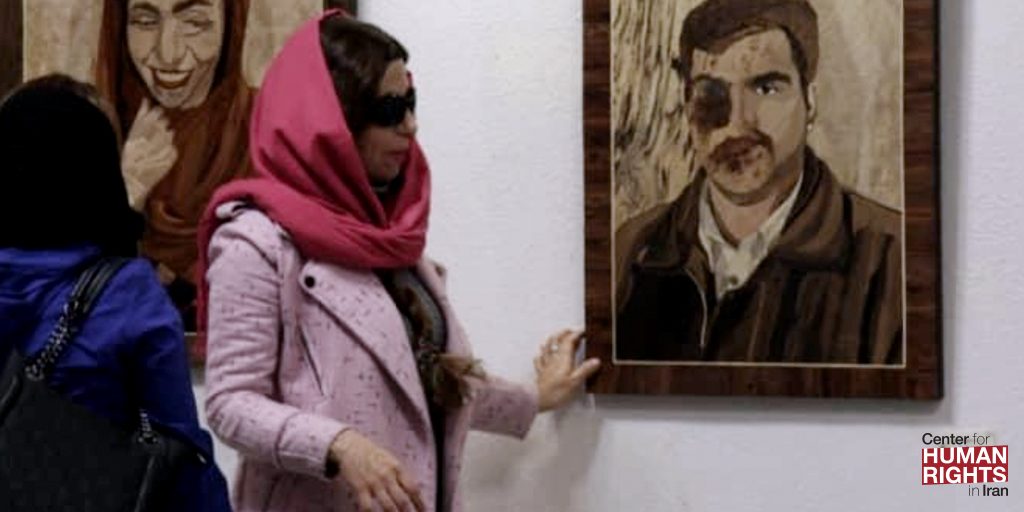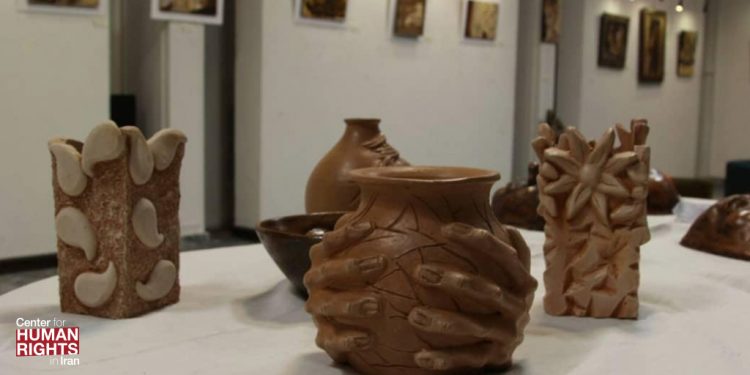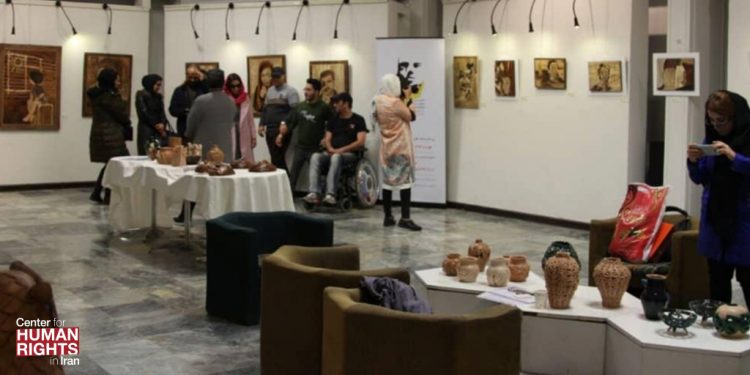Tehran Art Exhibition Showcases Works by Acid Attack Survivors

FEBRUARY
4, 2019
Victims Face Social Stigma and Inadequate
State Laws and Services
“How many more victims should acid take until
it’s banned, or its trade is limited, or a new law is passed so not everyone
dares to use acid as a weapon?” –Recent
acid survivor Zahra Yousof-Nejad
Highlighting the plight of
survivors of acid attacks, a new exhibit, “Identity,” recently opened in Tehran
which presents the work of acid attack survivors and other artists with
disabilities. The exhibit, which presents the impasto paintings of Mohsen
Mortazavi and other survivors, aims to raise awareness of the social stigma
faced by the survivors of these attacks.
The show is the fourth
exhibition of acid survivors and their artist supporters, in collaboration with The Association of Support for Acid Violence Victims and the State Handicrafts Institute.
Mortazavi chose the impasto
method, which involves layering the pain thickly so that it stands out from the
surface, in order to make his artwork accessible for fellow survivors who have
lost their eyesight as a result of acid violence. In addition to the work of
Mortazavi, the five-day exhibition at the Reza Abbasi Museum showcased the
ceramic art of survivor Masoumeh Attai, and the work of people with
disabilities and other supporting artists.
The organizers of the exhibit
stated their goal is to confront public assumptions and stop common intrusive
questions that survivors often endure.
“It’s really difficult to get
used to people’s prejudice,” said Mohsen Mortazavi, survivor and featured
artist in an interview with Iran Newspaper. “We’ve learned how to deal with
ourselves, but a lot of people can’t deal with us. We often have to tolerate
judgmental stares and cruel questions, and we’re expected to always answer.
‘How is the lawsuit going? Did you receive financial reparation?’ And these are
only the simple questions. Sometimes they really overstep boundaries. People
often ask me whether my wife stayed or got divorced after the incident. They
ask if my child is still living with me. But these aren’t questions we ask
regular people who have not been burned. People ask the disabled similar
questions too. So the Association organized this exhibition for people to see
us closer and understand that we too live and work like others.”
Inadequate Punishment and Easy
Public Access to Acid Encourage Attacks
 |
| The Islamic Penal Code offers no distinct punishment for acid attacks, and thus the perpetrator is sentenced to only two to four years of imprisonment for assault and battery as per Article 614 of the code. “Retaliation in Kind” (qisas) or retributive justice is included in this article but it is not often exercised due to the difficulty of maintaining damage proportion, leaving only the option of blood money or financial reparation. There exists an older law dating back to 1959, which was specifically drafted for cases of acid violence, yet is now rarely cited in courts. |
The Islamic Penal Code offers
no distinct punishment for acid attacks, and thus the perpetrator is sentenced
to only two to four years of imprisonment for assault and battery as per Article 614 of the code. “Retaliation
in Kind” (qisas) or retributive justice is included in this article but it is
not often exercised due to the difficulty of maintaining damage proportion,
leaving only the option of blood money or financial reparation. There exists an
older law dating back to 1959, which was specifically drafted for cases of acid
violence, yet is now rarely cited in courts.
Furthermore, this law does not
consider other aspects of this issue such as prevention of access to acid. The
growing number of acid attacks in the country testifies to the inadequacy and
ineffectiveness of the penal code and other legal measures which have so far
attempted to prevent acid attacks.
Urgently Needed New Bill
Pending Approval
The growing number of acid
attacks in the country testifies to the inadequacy and ineffectiveness of the
penal code and other legal measures which have so far attempted to prevent acid
attacks.
As for recent legal
developments, Tehran MP Fatemeh Hosseini announced the adoption of a new bill “Exacerbation of Punishment for
Acid Crimes and Support for Victims,” which was enacted in the January 1
meeting of the Parliament’s Judicial Commission.
“This draft bill is awaiting
approval in the Open Session, after which it will be sent to the Guardian
Council for enactment,” explained Hosseini, who designed and proposed the bill
herself. “As for exacerbating the punishment for acid attacks, we have added
Degree 1-4 imprisonment in addition to qisas (retaliation in kind).”
The lack of restricted public
access to acid presents a major legal shortcoming in preventing acid crimes.
“Another issue that highly concerns women’s rights activists is the lack of
supervision on acid trade in our society, to a degree that in every alley and
on every street one can easily find and access this dangerous material,” says Fatemeh Zolghadr, a
member of the Parliament’s Women’s Faction in an interview with Arman
Newspaper.
“There must be a system of
supervision for selling and purchasing acid,” she added. “Permits should be
required too, so not every child or adult can easily buy and sell acid. This is
why we’ve added these details to the bill, and now we’re waiting for the Open
Session.”
Lack of Statistics and Reliable
Database
There are no accurate
statistics on the number of acid attacks in Iran. According to the former director of
the Motahari Burn Injury Hospital, there are about 60 to 70 acid attack
survivors in the country every year. This number has increased significantly
during the past year. For instance, only within the first forty days of the
Iranian New Year (March 20-April 30 2018), seven cases of acid attacks were
reported, five of which took place in Tabriz.
Seyyed Kamal Foroutan, Plastic
Surgeon and a Board Member of the Association of Support for Acid Violence
Victims state that the number of acid attacks is far higher than what the
reports suggest. “It seems as if there are people who don’t want these statistics
to be published,” he added, critiquing the dearth of
official statistics. “Only in 2016 we had 57 or 58 cases of acid attacks in
Tehran. This shows that the number is no less in other cities.”
The founders of the Association
of Support for Acid Violence Victims have publicly encouraged all survivors to
contact and reach out to the organization as a first step to collect reliable
data.
Masoumeh Attai, a survivor and
member of the Association’s Directing Board announced in an interview with Ana News Agency:
“Only in this short one-month period since our opening, men and women from all
over the country have contacted me and expressed their urgent need for aid and
support. These are people who have never been mentioned in the newspaper cases.
People who need therapy,
medical care and legal assistance and who are now bound to their homes.”
The Association of Support for
Acid Violence Victims was established in May 2017 by a number of acid
survivors, burn and plastic surgeons, social workers and artists.
Acid Survivors Need Urgent and
Multifaceted State Support
A survivor who agreed to speak
with CHRI anonymously, discussed the services the government offers. “They
treated us exactly like a person whose disabilities are caused by a car
accident.
They did not recognize that the
loss of sight or hearing or physical disabilities are only a small part of an
acid survivor’s problems. Due to the severe social and mental effects of such
incidents and the resulting exclusion and isolation, we need the government’s
multifaceted support.”
“After the incident, no one
from the State Welfare Organization or any other governmental organization came
to my support,” she continued. “Only five years after the incident I learned
about SWO’s services through some friends. The SWO staff reviewed my case like
all other clients and paid no attention to the urgency of my situation or my
special needs. After twenty months of waiting, they recently started my $38
monthly pension. This is the same amount of money they give to all other people
with disabilities.”
Due to the drastic changes in
physical appearance and the potential loss of sight, psychological support and
therapy for the survivors and their families is especially critical during the
first months after the incident. According to this survivor and previous media
reports, however, the government has provided no such assistance for survivors.
Acid Attacks: the Product of A
Patriarchal Culture
 |
| Approximately 1500 acid attacks are annually recorded around the world, 80% of which target women. It has been estimated that a large number of the incidents remain unreported due to the victim’s fear of retaliation by the perpetrator or of social stigma, lack of access to medical services or legal support, and lack of an organized system in most countries for recording and collecting data and statistics. Acid Survivors Trust Internationalestimates that 60% of all attacks worldwide aren’t reported. |
Approximately 1500 acid attacks
are annually recorded around the world, 80% of which target women. It has been
estimated that a large number of the incidents remain unreported due to the
victim’s fear of retaliation by the perpetrator or of social stigma, lack of
access to medical services or legal support, and lack of an organized system in
most countries for recording and collecting data and statistics. Acid Survivors Trust
Internationalestimates that 60% of all attacks worldwide
aren’t reported.
ASTI also emphasizes the
difficulty to obtain official statistics on acid attack numbers in Iran.
“When there are many forms of
structural and cultural violence embedded in society, physical violence becomes
normal,” said Legal Expert Farshad
Esmaili in a 2015 meeting on the legal aspects of acid violence. “In our
country too, one must study these structures of violence to understand the
reason behind such attacks against women.”
In late 2014, a series of acid attacks took place in the Iranian city of Isfahan, which involved
unidentified men flinging acid into the faces of women with whom they had no
history of personal grudges. Eyewitnesses reported at the time that the
assailants proclaimed they were defending proper hijab during the assaults.
Emphasizing patriarchy as the
root cause of these forms of violence, Esmaili added, “This is caused by the
structural violence prevalent in our law, as well as a patriarchal history that
grants men the right to possess women and to assume authority even after the
end of a relationship. Therefore they feel entitled to eliminate the body and
the beauty that is no longer in their possession.”
No comments:
Post a Comment